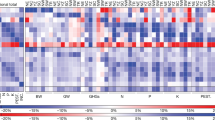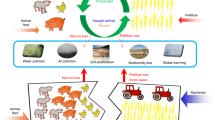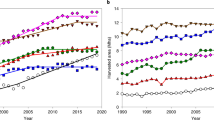Abstract
Brazilian grain production increased more than fourfold from 1980 to 2016. The grain boom was achieved primarily by soybean–corn double cropping and cropland expansion—both show changing spatiotemporal patterns since the 1980s. Here, we quantified the contributions of these two strategies to corn and soybean production in Brazil using municipality-level data from 1980 to 2016. We found the contribution of double cropping to the grain boom steadily increased to 35% and the largest driving force was the increasing demand for grain export. While double cropping dominated the conventional agricultural regions, cropland expansion was still the major strategy in agricultural frontiers such as the Centre-West and Matopiba. The implementation of double cropping offset the equivalent of 76.7 million ha of Brazilian arable land for grain production from 2003 to 2016. Double cropping in Brazil has the potential to help alleviate land burdens in other pantropical countries with increasing global food demand.
This is a preview of subscription content, access via your institution
Access options
Access Nature and 54 other Nature Portfolio journals
Get Nature+, our best-value online-access subscription
$29.99 / 30 days
cancel any time
Subscribe to this journal
Receive 12 digital issues and online access to articles
$119.00 per year
only $9.92 per issue
Buy this article
- Purchase on Springer Link
- Instant access to full article PDF
Prices may be subject to local taxes which are calculated during checkout








Similar content being viewed by others
Data availability
The data that support the findings of this study are available at https://www.ibge.gov.br/.
Code availability
The codes used for data processing, analysis and visualization during the current study are available from the corresponding author on reasonable request.
References
FAOSTAT Countries by Commodity (Food and Agriculture Organization of the United Nations, accessed 29 November 2019); http://www.fao.org/faostat/en/#rankings/countries_by_commodity
FAOSTAT Crops (Food and Agriculture Organization of the United Nations, accessed 29 November 2019); http://www.fao.org/faostat/en/#data/QC
Freitas, R. E. Expansion of agricultural areas in Brazil from 1994 to 2013: soybeans versus corn versus cotton. Organ. Rurais Agroindustriais 19, 219–232 (2017).
Cohn, A. S., VanWey, L. K., Spera, S. A. & Mustard, J. F. Cropping frequency and area response to climate variability can exceed yield response. Nat. Clim. Change 6, 601–604 (2016).
Zalles, V. et al. Near doubling of Brazil’s intensive row crop area since 2000. Proc. Natl Acad. Sci. USA 116, 428–435 (2019).
Ramalho, M. A. P., Dias, L. A., dos, S. & Carvalho, B. L. Contributions of plant breeding in Brazil: progress and perspectives. Crop Breed. Appl. Biotechnol. 12, 111–120 (2012).
Rada, N. & Valdes, C. Policy, Technology, and Efficiency of Brazilian Agriculture Economic Research Report No. 137 (USDA Economic Research Service, 2012).
Strassburg, B. B. N. et al. Moment of truth for the Cerrado hotspot. Nat. Ecol. Evol. 1, 0099 (2017).
Karstensen, J., Peters, G. P. & Andrew, R. M. Attribution of CO2 emissions from Brazilian deforestation to consumers between 1990 and 2010. Environ. Res. Lett. 8, 024005 (2013).
Soares-Filho, B. et al. Role of Brazilian Amazon protected areas in climate change mitigation. Proc. Natl Acad. Sci. USA 107, 10821–10826 (2010).
Zhang, Y. et al. Dramatic cropland expansion in Myanmar following political reforms threatens biodiversity. Sci. Rep. 8, 16558 (2018).
Kehoe, L. et al. Biodiversity at risk under future cropland expansion and intensification. Nat. Ecol. Evol. 1, 1129–1135 (2017).
Noojipady, P. et al. Forest carbon emissions from cropland expansion in the Brazilian Cerrado biome. Environ. Res. Lett. 12, 025004 (2017).
Mandemaker, M., Bakker, M. & Stoorvogel, J. The role of governance in agricultural expansion and intensification: a global study of arable agriculture. Ecol. Soc. 16, 8 (2011).
Yu, Q., Xiang, M., Wu, W. & Tang, H. Changes in global cropland area and cereal production: an inter-country comparison. Agric. Ecosyst. Environ. 269, 140–147 (2019).
Zabel, F. et al. Global impacts of future cropland expansion and intensification on agricultural markets and biodiversity. Nat. Commun. 10, 2844 (2019).
Pellegrini, P. & Fernández, R. J. Crop intensification, land use, and on-farm energy-use efficiency during the worldwide spread of the green revolution. Proc. Natl Acad. Sci. USA 115, 2335–2340 (2018).
Tilman, D., Balzer, C., Hill, J. & Befort, B. L. Global food demand and the sustainable intensification of agriculture. Proc. Natl Acad. Sci. USA 108, 20260–20264 (2011).
Ceddia, M. G., Bardsley, N. O., Gomez-y-Paloma, S. & Sedlacek, S. Governance, agricultural intensification, and land sparing in tropical South America. Proc. Natl Acad. Sci. USA 111, 7242–7247 (2014).
Ray, D. K. & Foley, J. A. Increasing global crop harvest frequency: recent trends and future directions. Environ. Res. Lett. 8, 044041 (2013).
Wu, W. et al. Global cropping intensity gaps: increasing food production without cropland expansion. Land Use Policy 76, 515–525 (2018).
Arvor, D., Dubreuil, V., Simões, M. & Bégué, A. Mapping and spatial analysis of the soybean agricultural frontier in Mato Grosso, Brazil, using remote sensing data. GeoJournal 78, 833–850 (2013).
Spera, S. A. et al. Recent cropping frequency, expansion, and abandonment in Mato Grosso, Brazil had selective land characteristics. Environ. Res. Lett. 9, 064010 (2014).
Spangler, K. R., Lynch, A. H. & Spera, S. A. Precipitation drivers of cropping frequency in the Brazilian Cerrado: evidence and implications for decision-making. Weather Clim. Soc. 9, 201–213 (2017).
Abrahão, G. M. & Costa, M. H. Evolution of rain and photoperiod limitations on the soybean growing season in Brazil: the rise (and possible fall) of double-cropping systems. Agric. Forest Meteorol. 256–257, 32–45 (2018).
Martinelli, L. A., Batistella, M., Bicudo da Silva, R. F. & Moran, E. Soy expansion and socioeconomic development in municipalities of Brazil. Land 6, 62 (2017).
VanWey, L. K., Spera, S., de Sa, R., Mahr, D. & Mustard, J. F. Socioeconomic development and agricultural intensification in Mato Grosso. Phil. Trans. R. Soc. B 368, 20120155 (2013).
Arvor, D., Meirelles, M., Dubreuil, V., Bégué, A. & Shimabukuro, Y. E. Analyzing the agricultural transition in Mato Grosso, Brazil, using satellite-derived indices. Appl. Geogr. 32, 702–713 (2012).
Dias, L. C., Pimenta, F. M., Santos, A. B., Costa, M. H. & Ladle, R. J. Patterns of land use, extensification, and intensification of Brazilian agriculture. Glob. Change Biol. 22, 2887–2903 (2016).
Barretto, A. G. O. P., Berndes, G., Sparovek, G. & Wirsenius, S. Agricultural intensification in Brazil and its effects on land-use patterns: an analysis of the 1975–2006 period. Glob. Change Biol. 19, 1804–1815 (2013).
Flexor, G. & Leite, S. P. Land market and land grabbing in Brazil during the commodity boom of the 2000s. Contexto Int. 39, 393–420 (2017).
Spera, S. A., Galford, G. L., Coe, M. T., Macedo, M. N. & Mustard, J. F. Land-use change affects water recycling in Brazil’s last agricultural frontier. Glob. Change Biol. 22, 3405–3413 (2016).
Santos de Araújo, M. L. et al. Spatiotemporal dynamics of soybean crop in the Matopiba region, Brazil (1990–2015). Land Use Policy 80, 57–67 (2019).
Lima, M., da Silva, C. A. Jr, Rausch, L., Gibbs, H. K. & Johann, J. A. Demystifying sustainable soy in Brazil. Land Use Policy 82, 349–352 (2019).
Jepson, W. Private agricultural colonization on a Brazilian frontier, 1970–1980. J. Hist. Geogr. 32, 839–863 (2006).
Bicudo da Silva, R. F. et al. The Sino–Brazilian telecoupled soybean system and cascading effects for the exporting country. Land 6, 53 (2017).
Fuchs, R. et al. Why the US–China trade war spells disaster for the Amazon. Nature 567, 451–454 (2019).
Allen, E. & Valdes, C. Brazil’s Corn Industry and the Effect on the Seasonal Pattern of US Corn Exports (USDA Economic Research Service, 2016).
Garrett, R. D., Lambin, E. F. & Naylor, R. L. The new economic geography of land use change: supply chain configurations and land use in the Brazilian Amazon. Land Use Policy 34, 265–275 (2013).
Simões, D. d. C., Caixeta-Filho, J. V. & Palekar, U. S. Fertilizer distribution flows and logistic costs in Brazil: Changes and benefits arising from investments in port terminals. Int. Food Agribus. Man. Rev. 21, 407–422 (2018).
Alliprandini, L. F. et al. Understanding soybean maturity groups in Brazil: environment, cultivar classification, and stability. Crop Sci. 49, 801–808 (2009).
da S. Andrea, M. C., Boote, K. J., Sentelhas, P. C. & Romanelli, T. L. Variability and limitations of maize production in Brazil: potential yield, water-limited yield and yield gaps. Agric. Syst. 165, 264–273 (2018).
Dias, F. S. et al. Agronomic responses of maize hybrids to row spacing and plant population in the summer and winter seasons in Brazil. Agron. J. 111, 3119–3129 (2019).
de A. Salvador, M. & de Brito, J. I. B. Trend of annual temperature and frequency of extreme events in the MATOPIBA region of Brazil. Theor. Appl. Climatol. 133, 253–261 (2018).
Xiong, J. et al. Automated cropland mapping of continental Africa using Google Earth Engine cloud computing. ISPRS J. Photogramm. Remote Sens. 126, 225–244 (2017).
Waha, K. et al. Multiple cropping systems of the world and the potential for increasing cropping intensity. Glob. Environ. Change 64, 102131 (2020).
Data: Agricultural Land (% of Land Area) (World Bank Group, 2016).
Pesquisas Agropecuárias (IBGE, 2018); https://biblioteca.ibge.gov.br/visualizacao/livros/liv101552.pdf
de Miranda, E. E., Magalhães, L. A. & de Carvalho, C. A. Proposta de Delimitação Territorial do MATOPIBA Nota Técnica 01.2014.18 (GITE/Embrapa, 2014).
R Core Team R: A Language and Environment for Statistical Computing (R Foundation for Statistical Computing, 2018).
Toms, J. D. & Lesperance, M. L. Piecewise regression: a tool for identifying ecological thresholds. Ecology 84, 2034–2041 (2003).
Muggeo, V. M. R. Segmented: An R package to fit regression models with broken-line relationships. R News 8, 20–25 (2008).
Sparovek, G. et al. Asymmetries of cattle and crop productivity and efficiency during Brazil’s agricultural expansion from 1975 to 2006. Elementa Sci. Anthrop. 6, 25 (2018).
Ang, B. W. LMDI decomposition approach: a guide for implementation. Energy Policy 86, 233–238 (2015).
Guan, D. et al. Structural decline in China’s CO2 emissions through transitions in industry and energy systems. Nat. Geosci. 11, 551–555 (2018).
Zhou, F. et al. Deceleration of China’s human water use and its key drivers. Proc. Natl Acad. Sci. USA 117, 7702–7711 (2020).
Blomqvist, L., Yates, L. & Brook, B. W. Drivers of increasing global crop production: a decomposition analysis. Environ. Res. Lett. 15, 0940b6 (2020).
Acknowledgements
This work was partially funded by the National Natural Science Foundation of China under grant nos 31701316 and 32071894, the Chinese Scholarship Council under grant no. 2017DFJ002032 and Zhejiang University.
Author information
Authors and Affiliations
Contributions
J.X. and T.L. conceived and designed the experiments; J.X., H.V.d.H. and T.L. performed the experiments; J.X., J.G., H.V.d.H., R.Z., H.J. and T.L. analysed the data; J.X., J.G., L.F.R., J.V.C.-F., H.L., Z.D., X.W., S.W., K.C.T., Y.Y. and T.L. contributed materials/analysis tools; J.X., J.G., H.V.d.H., L.F.R., J.V.C.-F., H.L., Z.D., X.W., S.W., K.C.T., Y.Y. and T.L. wrote the paper.
Corresponding author
Ethics declarations
Competing interests
The authors declare no competing interests.
Additional information
Peer review information Nature Food thanks Michaela Theurl, Michael Obersteiner and the other, anonymous, reviewer(s) for their contribution to the peer review of this work.
Publisher’s note Springer Nature remains neutral with regard to jurisdictional claims in published maps and institutional affiliations.
Supplementary information
Supplementary Information
Supplementary Figs 1–6 and Tables 1 and 2.
Rights and permissions
About this article
Cite this article
Xu, J., Gao, J., de Holanda, H.V. et al. Double cropping and cropland expansion boost grain production in Brazil. Nat Food 2, 264–273 (2021). https://doi.org/10.1038/s43016-021-00255-3
Received:
Accepted:
Published:
Issue Date:
DOI: https://doi.org/10.1038/s43016-021-00255-3
This article is cited by
-
Low-opportunity-cost feed can reduce land-use-related environmental impacts by about one-third in China
Nature Food (2023)
-
Risk assessment and validation of farmland abandonment based on time series change detection
Environmental Science and Pollution Research (2023)
-
Warming reduces global agricultural production by decreasing cropping frequency and yields
Nature Climate Change (2022)
-
The impact of climate change in wheat and barley yields in the Iberian Peninsula
Scientific Reports (2021)



